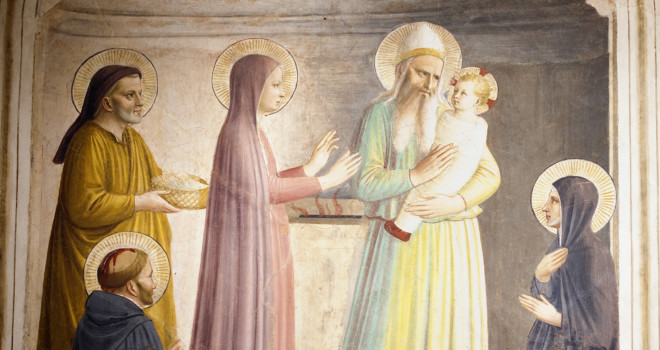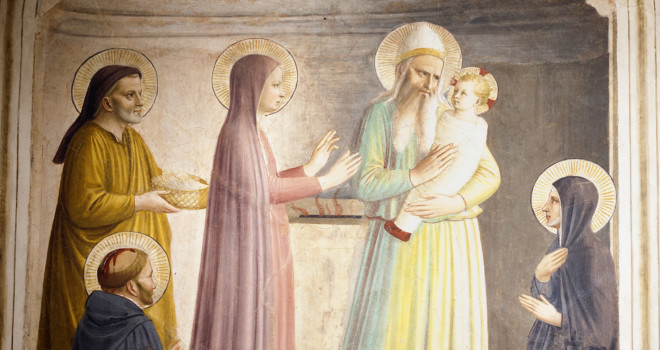Lessons from Presentation of Jesus in the Temple by Fra Angelico
This holy feast day give us an opportunity to look at some of the best art that Christian civilization has to offer. Specifically, Presentation of Jesus in the Temple by Bl. Giovanni di Fiesole, also known as Fra Angelico (whose feast day is approaching on February 18), which offers important and powerful lessons for those of us who desire to become better disciples of Jesus. While this fresco from the mid-fifteenth century occupies a wall of a Dominican monastery in Florence, Italy, it still offers many lessons even in our modern world. We ought to take time to gaze upon it, meditate on its details, and ask how it applies to our lives.
We learn much from gazing upon the faces of the three biblical figures in the painting. The first apparent lesson comes from the focal point of the painting, right near Jesus. Specifically, we notice Simeon, the man who took Jesus into his arms and spoke two powerful prophecies in the Temple. In Fra Angelico’s rendition of this event, Simeon’s eyes focus unwaveringly on the Lord. He looks intently upon Jesus and nowhere else. This small, significant detail helps us remember that to speak forth the mind of the Lord, which all of us must do in some way, means we must gaze upon Him fully and constantly.
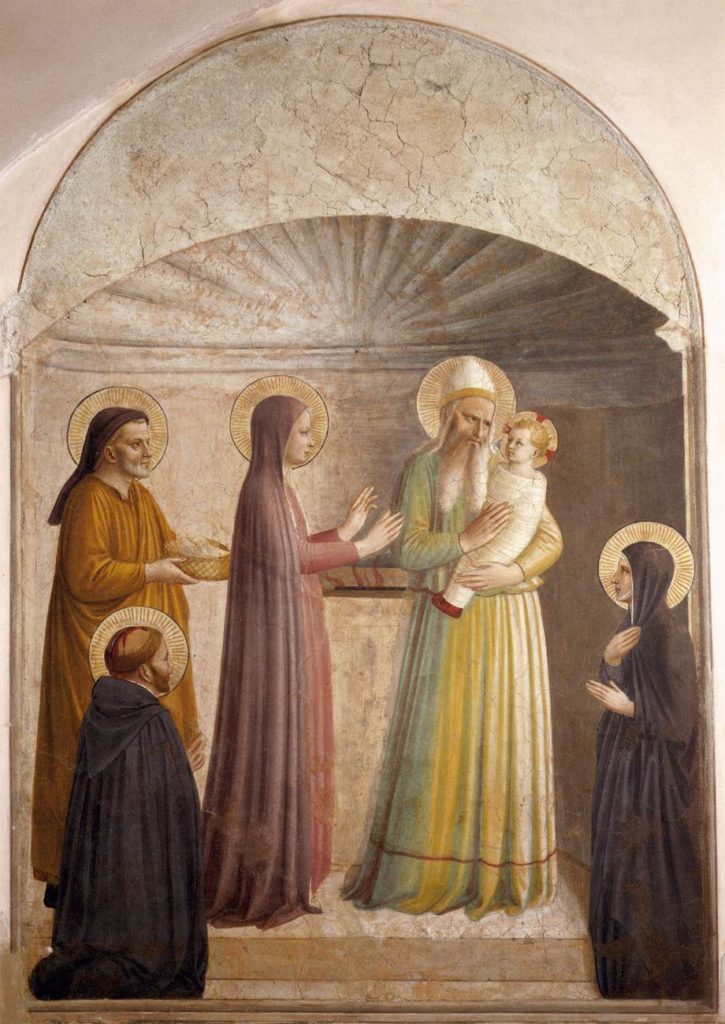
The next striking facial expression is the look of trepidation on Mary’s face. Her look is accompanied by contorted fingers. It is as if she is grasping at Jesus in order to delay the mission for which He has entered the world. She knows the impending reality of suffering and pain (see Lk. 2:34-35). Yet, as a mother, she wants to prevent or delay it. Mary’s gaze and her grasp in this moment remind us of the spirit of obedient sacrifice that she exhibited; and that all disciples must learn, even when we are less than eager to suffer. Like Mary, we must understand that God’s will and plan are better than what we might choose for ourselves. So, with Mary, we must assent again and again, “…let it be to me according to your word” (Lk. 1:38); and with Jesus, “…not my will, but yours, be done” (Lk. 22:42). This is why the flames on the altar are important: our wills must be consumed on the altar of sacrifice in the loving fire of God’s perfect will.
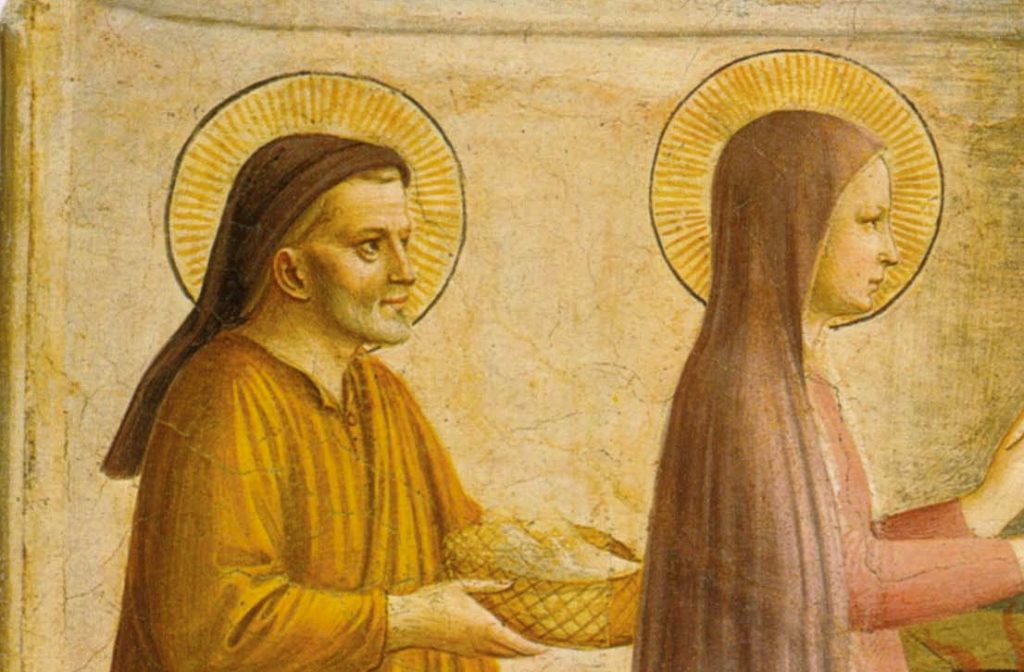
We also note the look of eager anticipation the artist places on the face of the third biblical figure, St. Joseph. Joseph is looking for something great to happen. He is expecting the fulfillment of what the angel told him in the first dream: “that which is conceived in her is of the Holy Spirit” and Jesus “will save his people from their sins” (Mt. 1:20-21). During this Year of St. Joseph, we should seek to get to know the earthly father of Jesus more fully and learn why he anticipates the work of our Blessed Lord so fully, deeply, and eagerly.
Beyond the look on his face, we also note that St. Joseph is holding a basket with the “pair of turtledoves” (Lk. 2:24). This detail has deeper meaning than the simple fact that Mary probably would have been carrying the Baby, so Joseph needed to be a helpful husband and parent, carrying the other luggage. Turtle doves signify springtime and new life. In the New Covenant, St. Joseph is the first guardian of the new spiritual springtime that is about to come upon the earth, specifically through the New Adam and the New Eve.

There is another significance of this specific bird. Turtledoves are a symbol of relationship between lovers. They are even iconic of the beloved person. The author of the Song of Songs exclaims, “O my dove…let me see you face, let me hear your voice” (Song 2:14); and “My dove, my perfect one, is only one” (Song 6:9). We know that God, the Father, has given His beloved and perfect Son to save us because the Father wants to be in a deep, life-giving relationship with each of us. We know that Jesus is the Bridegroom who cherishes each of us to the point of death. In this painting, Joseph stands as a spiritual father who is prepared to give away his daughter, the Church, to a bridegroom who will love and cherish and protect her always. St. Joseph wants to present each of us to Jesus, the Perfect Bridegroom.
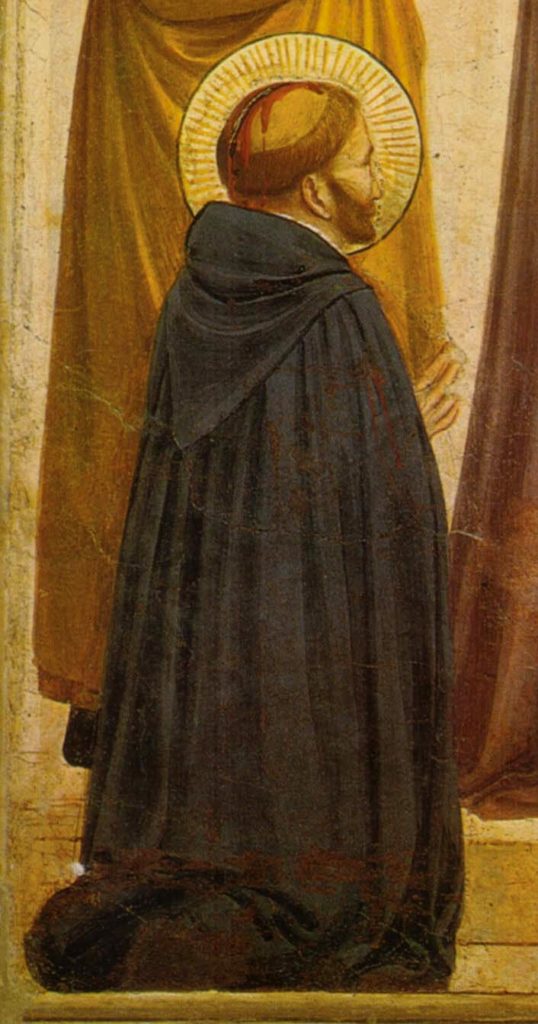
Finally, the two other figures in the painting have important lessons to teach us. They are two Dominican saints: Bl. Villana de’ Botti (A.D. 1332-1361) and St. Peter of Verona (A.D. 1205-1252). Bl. Villana experienced a major conversion after leading a wealthy, worldly, and empty life as a young woman. She became a lay Dominican devoted to the study of Scripture and contemplation of Jesus. St. Peter of Verona was martyred by one of the many enemies he made while preaching against heresy in northern Italy. He held nothing back in making every effort to ensure the truth was proclaimed in the world.
Each of these details remind us that every disciple is called to turn toward Jesus and focus on Him intently; to look forward in joyful hope to what the Lord will write into us and into the world; and to lay down our lives in total obedience and conformity to His will. Let’s ask for the intercession of each of these holy men and women as we begin and continue our efforts.
✠
featured image: The Presentation of Jesus at the Temple by Fra Angelico from the Monastery of St. Mark, Florence / Shutterstock
Other image details are from a public domain image via Wikimedia Commons.


